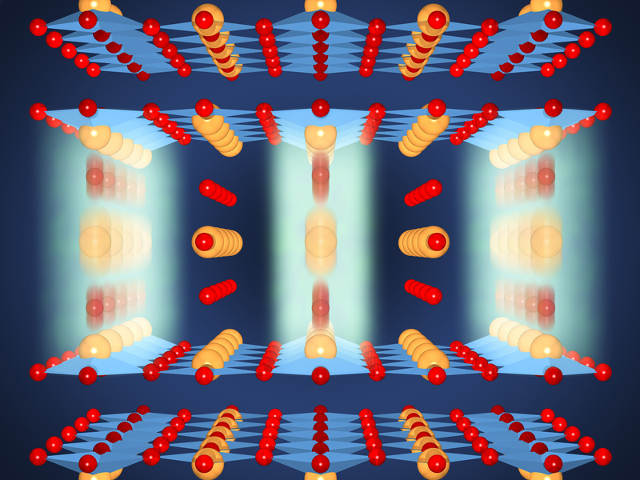An international team of researchers including physicists from the Max Planck Institute for the Structure and Dynamics of Matter in Hamburg have presented a possible mechanism for superconductivity at room temperature.
 No resistance at room temperature: The resonant excitation of oxygen oscillations between copper oxide double layers with short light pulses leads to a widening of the layers, briefly allowing room-temperature conductivity © Jörg Harms/MPI for the Structure and Dynamics of Matter
No resistance at room temperature: The resonant excitation of oxygen oscillations between copper oxide double layers with short light pulses leads to a widening of the layers, briefly allowing room-temperature conductivity © Jörg Harms/MPI for the Structure and Dynamics of Matter
Superconductors are materials which have the ability to transport electric current without any resistance or losses. The first examples of this phenomenon to be discovered only worked at temperatures just above absolute zero (-273°C).
Later, ceramic superconducting materials, primarily yttrium barium copper oxide (YBCO), were found to transition into their superconducting state at 90K or higher (about -180°C) - this class of materials is referred to as high-temperature superconductors.
These discoveries led to a hope that these developments would continue, eventually resulting in superconductors that would not require any cryogenic cooling. However, these room-temperature superconductors have remained elusive, and even the mechanism by which high-temperature superconductivity occurs is not yet fully understood.
Superconducting crystal structure
YBCO crystals are made up of copper oxide, copper, barium and oxygen layers. The thin copper oxide double layers alternate with thicker barium, copper and oxygen intermediate layers.
Superconductivity originates in the thin copper oxide double layers, where pairs of electrons interacting through the crystal lattice, called Cooper pairs, are formed.
When the YBCO crystal becomes superconducting, the Cooper pairs tunnel within the double layers and also through the thicker layers. This phenomenon occurs below the critical temperature - if the temperature rises above this critical temperature, the double layer coupling disappears and the material becomes a poor metallic conductor.
It could assist materials scientists to develop new superconductors with higher critical temperatures, and ultimately to reach the dream of a superconductor that operates at room temperature and needs no cooling at all.
Roman Mankowsky, lead author
Pulsed laser creates moments of superconductivity
An international team led by Andrea Cavalleri of the Max Planck Institute recently discovered that YBCO could be made to superconduct at room temperature, by irradiation with infrared laser pulses.
The team used a high-powered X-ray beam at the Linac Coherent Light Source (LCLS) at SLAC in the US to examine the crystal structure of the material immediately after irradiation with the infrared laser.
This revealed that the infrared pulses were causing the oxygen atoms within the crystal to oscillate by resonant excitation. This additional oscillation widens the gap between the individual copper oxide layers by 2 picometres (10-12 metres), decreasing the separation betwen double layers by the same amount.
This shift in structure led to an increase in the quantum coupling between the double layers, sufficient to cause the material to become superconducting at room temperature for a few picoseconds.
The findings of this study could help advance the theory of high-temperature superconductors, and provide valuable insights for the scientists trying to design materials which can superconduct at higher temperatures, and even at room temperature.
Sources & further reading